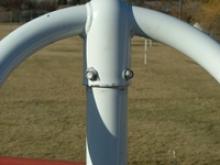
Entanglement is a “…condition in which the user’s clothing or something around the user’s neck becomes caught or entwined on a component of playground equipment.”1
The causes of entanglement include projections, protrusions, and open hooks, such as “S” hooks and gaps, that could entrap a child’s clothing.
If a bolt or a part of a playground component is projecting out from the play equipment and is accessible, playground inspectors will place the three successively larger protrusion gauges over it. If the projection extends beyond the face of any of the three gauges, it is considered a protrusion. If the projection increases in diameter from the initial surface toward the exposed end, it is considered to be an entanglement hazard.2
Protrusions also include bolts that extend beyond the nut for more than two threads. These hazards can also cause lacerations and impalement as well as entanglement.3
Open hooks such as “S” hooks or “C” hooks can entangle clothing. This can be especially hazardous on swings.
On swings, there is a potential for impact incidents, so it is especially important not to have any projection. To determine if there is a projection, the projection gauge for swings is placed over the projection. Any projection that extends beyond the face of the gauge is a protrusion.4
Slides have the potential for impact incidents and clothing entanglement incidents. Any projections that extend beyond the face of the projection gauge in the position of intended travel are considered protrusions. The undersides of slides are not subject to this test but are subject to the general protrusion requirements. Any spaces or gaps on a slide that might entangle drawstrings or clothing are particularly hazardous. Gaps are sometimes found between the platform and the slide bedway.
Projections that are protrusions may cause impalement or lacerations. Gaps or projections that entangle clothing or drawstrings may cause strangulation.
- 1. ASTM International (ASTM) standard F 1487-11, “Standard Consumer Safety Performance Specification for Playground Equipment for Public Use,” 3.1.12, p. 3.
- 2. U.S.Consumer Product Safety Commission (CPSC) Publication #325-10, “Public Playground Safety Handbook,” Figure 2, p. 14.
- 3. Ibid, CPSC, Figure 3, p. 14.
- 4. Ibid, CPSC, 5.3.8.5, p. 41.

